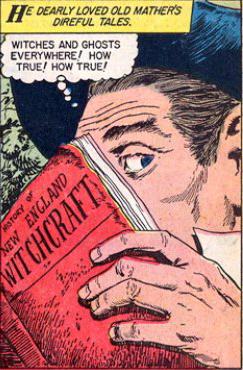
from The Legend of Sleepy Hollow, adapted by Levin and Livingstone, in Classic Comics #12
Updated Wednesday, 9/12.
9/7-9/14
All work is due by midnight on Friday, 9/21 due to potential storm impact.
Thanks go out to the Writing Group for their input for this week!
Below is a detailed list of what’s to be completed this week.
- Read: What is a Myth? and Myths & Archetypes for a little more background on that aspect of the theme.
Read: The New Digital Storytelling: Creating Narratives with New Media Chapter 1, “Storytelling for the Twenty-First Century,” to start thinking about what is storytelling and what is digital storytelling. A PDF is in the Files section of Canvas.
Watch Vonnegut on The Shape of Stories: https://www.youtube.com/watch?v=oP3c1h8v2ZQ to start thinking about the structure of stories.
Read some more: No one becomes a good storyteller without being a good story reader. This is something we should be thinking about throughout this course. By “being a good story reader” I mean not just absorbing the tale, but also, or rather more importantly, critically examining how it is told, whether in words, images, sounds, objects, or anything else, or in any combination thereof. What makes a great book great is the use of language as much as the plot. Photography, design, audio and video all have languages of their own, and we’ll be looking at those in the coming weeks.
This week, you need to read/view one theme-related story, and analyze it. What makes it a good story? What storytelling techniques are being used effectively? We have some suggestions for you to use:
Lost Tapes: an Animal Planet mockumentary series featuring creatures of myth and legend.
Freebookapalooza is a collection of public domain myth and folklore. If you’re interested in traditional tales, this is the place to go.
American Gods is a Neil Gaiman novel that’s been adapted for television (YT, Amazon) and comics.
Since someone brought up Gaiman, I’ll throw in A Study in Emerald which is more mythopoeia than myth, but so what, he’s a good writer.
You can use one of the above, or you can choose something else, if you have an example of good storytelling in mind.
Bring it all together: How do the ideas in the readings and video apply to your chosen story? You may consider questions such as: What did you like about the story? What worked and what didn’t? How did the story develop character and setting? How did it hold your attention? These questions are only general suggestions to get you thinking. You will all probably have more and better ideas based on your readings. Write up your thoughts in a blog post and tag it storyanalysis. - Create a Character: Think about the kinds of characters you’ve encounter in and around myth, legend and folklore. Think about the archetypes. Which ones appeal to you? What makes them interesting? What makes them unique? Your challenge this week is to create a character related to our theme, whom you can use in the coming weeks to build stories around. Given the breadth of the theme, this character could be almost anything: hero, villain, wizard, storyteller, paranormal investigator, mothman, demigod… TV Tropes has a crazy long list of ideas if you think you need help, but don’t think you’re limited to that or tied to any traditions. The important thing is that it’s something you can be creative with and have fun.
Write a narrative post introducing your character. What is the back story? Tag the post: character - Writing Assignments: This week, we will be using Writing Assignments from ds106’s Assignment Bank. Each assignment comes with a “star” or point rating that roughly estimates its difficulty. You must complete at least 10 stars of writing assignments. You might consider doing A Snapshot of a Story or Random Wikipedia Writing. Connect at least one of the assignments in some way to our theme and/or the character you create.
Note: You started creating assignments last week. You can do this at any time. So if you don’t like the writing assignments as they are, you are welcome to come up with a new one and do it yourself. - Daily Creates: Let’s do 3 this week.
- Commenting: You should all be following each other’s work and offering each other feedback, ideas, support and encouragement. Several people have been doing this already, which is great, but more is better. A good habit is to visit the course site every day to see what people have posted. Click through to a few posts and share your thoughts on the work, and ideas that it may inspire. We all appreciate positive feedback, and we can all be inspired by each other. This should take no more than a few minutes a day.
- Questions to think about:
What makes a good blog post title? A creative title? How does a title make you want to read the post?
How is writing for the web different? How does it change the way we write? - Write your Weekly Summary: This is an every week thing. Your summary should link to or embed all your work for the week, and give your thoughts on the week as a whole. Submit the URL for this post to Canvas by the end of the day on Friday.
